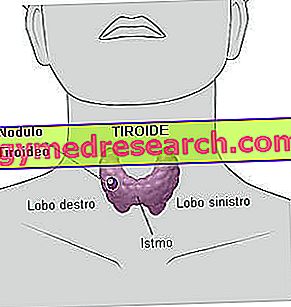Causes and Classification
Thyroid cancer is caused by the abnormal development of some cells of this gland, similar to a butterfly, located at the base of the neck just below the Adam's apple.
Thyroid cancer very often manifests itself in a benign form and rather rarely in malignant forms (assuming in this case the name of thyroid cancer).

Even more rare (less than 10% of cases) are malignant thyroid nodules, which can be of the following type:
- papillary: the most widespread of all (70-80% of thyroid carcinomas), is frequent in young patients (between 30 and 50 years) and is characterized by a low degree of malignancy, which still tends to increase in older patients .
- Follicular: it represents 5 to 15% of all thyroid tumors and is found mostly among the elderly. It is more aggressive than papillary carcinoma, but maintains a slow growth and a relatively favorable prognosis. Like the previous one, it affects the follicular cells of the thyroid gland (responsible for the synthesis of thyroid hormones T3 and T4).
- Medullary: represents about 4-5% of thyroid tumors and develops at the level of C cells, responsible for the production of the hormone calcitonin. It generally affects people over the age of 50 and is characterized by some peculiarities: it can in fact be sporadic or familial (hereditary transmission of abnormal genes) and be associated with other tumors or pathologies of the endocrine system. The prognosis is good when the carcinoma is limited to the thyroid and unfavorable in the presence of metastases.
- Anaplastic: it is now a rarity among thyroid carcinomas (about 1% of cases), it is found in the elderly with long standing goitre and has very high malignancy. It is characterized by the rapid and painful enlargement of the gland, affects the follicular cells and is very difficult to treat.
- Other rather rare malignant tumors are represented by thyroid lymphoma and squamous cell carcinoma.
The incidence of thyroid cancer in the overall scenario of malignant neoplasms is around one, one and a half percent, ranging from 10 to 40 new annual cases per million inhabitants. The increased incidence documented in recent years seems due, at least in part, to the improvement of ultrasound diagnostic techniques.
More common among women, thyroid carcinoma causes - with a certain approximation - 6 annual deaths per million inhabitants.
Thyroid tumor symptoms
To learn more: Thyroid Tumor Symptoms
As we have seen, in most cases, thyroid cancer grows very slowly and is minimally invasive. There is therefore a long latency period between tumor induction and clinical manifestations; consequently the disease often remains unrecognized throughout life.
The characteristic symptom is the presence of a nodule in the anterior region of the neck, corresponding to the anatomical site of the gland. As anticipated, however, only a small percentage of the nodules has malignant features.
Especially in young patients, the onset symptom may be represented by the enlargement of the laterocervical lymph nodes. At an advanced stage this symptom may be associated with changes in the tone of the voice (hoarseness - dysphonia), widespread pain in the anterior region of the neck and dysphagia (difficulty and pain on swallowing).
Risk factors
A nodule is more likely to be malignant when: it is not accompanied by thyrotoxicosis (it is classified as cold on scintigraphic examination), it increases in consistency (classified as solid on ultrasound examination), has irregular edges and intraparenchymal vasculature (with echocolordoppler) and causes compression disorders (dysphonia, dysphagia). Other risk factors in this sense are represented by the previous exposure to radiation (including those given for therapeutic purposes or associated with nuclear disasters) and by the familiarity for goitre and for syndromes such as medullary thyroid carcinoma, multiple endocrine neoplasia and adenomatous polyposis familiar. The incidence of follicular cancer is also greater in iodocarent areas, where nodular goiter is endemic (preventable with the use of iodized salt).
Thyroid tumors
X Problems with video playback? Reload from YouTube Go to Video Page Go to Wellness Destination Watch the video on youtube



